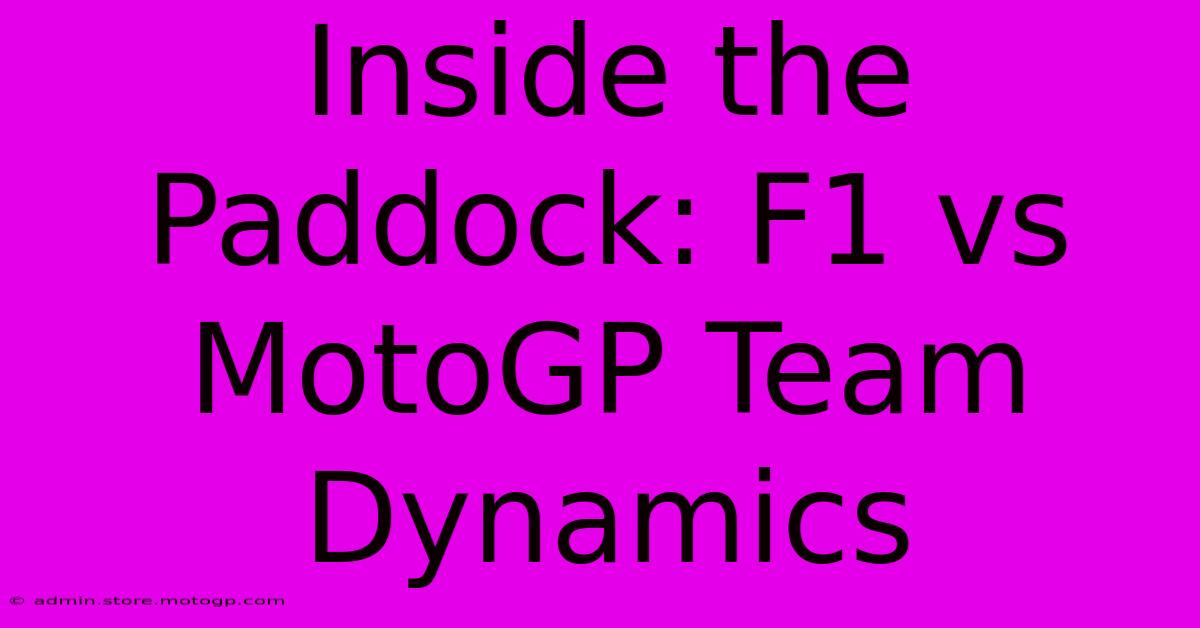Inside The Paddock: F1 Vs MotoGP Team Dynamics

Table of Contents
Inside the Paddock: F1 vs MotoGP Team Dynamics – A Tale of Two Sports
The roar of engines, the smell of burning rubber, the nail-biting tension – Formula 1 and MotoGP share a passion for speed and precision. But beneath the surface similarities lies a world of difference in team dynamics. While both strive for victory, their approaches to organization, personnel, and strategy reveal fascinating contrasts. This article delves into the unique team structures of these pinnacle motorsport series, comparing and contrasting their approaches to success.
The Hierarchical Structure of F1 Teams
Formula 1 teams are famously hierarchical. Think of a military operation, with a clear chain of command radiating from the Team Principal. This individual holds ultimate responsibility, overseeing everything from engineering and strategy to marketing and finance.
Key Roles and Responsibilities:
- Team Principal: The ultimate decision-maker.
- Technical Director: Leads the engineering department, responsible for car design and development.
- Chief Strategist: Oversees race strategy, tire management, and pit stop calls.
- Race Engineer: Works directly with the driver, providing real-time data and feedback.
- Driver: The face of the team, responsible for performance on track.
This rigid structure allows for specialized expertise and efficient decision-making in high-pressure situations. However, it can also stifle creativity and collaboration if not managed effectively. The emphasis is on meticulous planning and precise execution, mirroring the complexity of F1 cars themselves.
The More Collaborative World of MotoGP Teams
MotoGP teams, while still possessing a defined hierarchy, exhibit a more collaborative and less rigidly structured approach. The relationship between the rider and crew chief is paramount, often resembling a close partnership built on years of trust and mutual understanding.
A Different Kind of Leadership:
- Team Manager: Plays a similar role to the F1 Team Principal, but with a more hands-on approach, often heavily involved in rider management.
- Crew Chief: A crucial figure, deeply involved in bike setup and race strategy, fostering a strong rider-mechanic relationship.
- Rider: Possesses a significantly higher degree of influence over bike setup compared to F1 drivers.
- Engineers: Work closely with the rider and crew chief, providing technical expertise and support.
This collaborative nature allows for greater rider input in bike setup and strategy. This reflects the more instinctive and reactive nature of MotoGP racing, where rider skill and adaptability are crucial. While still requiring precise execution, MotoGP relies heavily on the rider's feel and feedback.
The Size and Scope of Operations:
Formula 1 teams are significantly larger, employing hundreds of personnel at sprawling factories. The scale of their operations reflects the intricacy of the cars and the vast resources involved in designing, building, and maintaining them. MotoGP teams are smaller, maintaining a more agile and responsive operation.
Strategy and Technological Advancements:
Both sports rely on meticulous strategy and cutting-edge technology. However, the application differs. F1’s strategic depth lies in tire management, pit stop execution, and complex car setup adjustments based on track conditions. MotoGP strategy centers on tire wear, race pace management, and adapting to varying track conditions, but with less reliance on complex car setup changes.
Conclusion: Distinct Approaches, Shared Passion
While both Formula 1 and MotoGP share the common goal of victory, their team dynamics represent strikingly different approaches. F1's hierarchical structure emphasizes meticulous planning and specialized roles, while MotoGP fosters a more collaborative atmosphere with greater rider involvement. Both models demonstrate the diverse ways in which high-performance teams can be organized to achieve success in the demanding world of motorsport. Understanding these differences provides valuable insight into the unique challenges and strategies employed at the pinnacle of motor racing.

Thank you for visiting our website wich cover about Inside The Paddock: F1 Vs MotoGP Team Dynamics. We hope the information provided has been useful to you. Feel free to contact us if you have any questions or need further assistance. See you next time and dont miss to bookmark.
Featured Posts
-
Moto2 The Bridge Between Supersport And Moto Gp
Feb 18, 2025
-
Cota Parking Make Your Race Day Seamless
Feb 18, 2025
-
Cota One Day Pass Budget Friendly Columbus Exploration
Feb 18, 2025
-
Race Bikes For Sale Conquer Any Terrain
Feb 18, 2025
-
Moto 2 Specs The Winning Edge
Feb 18, 2025
